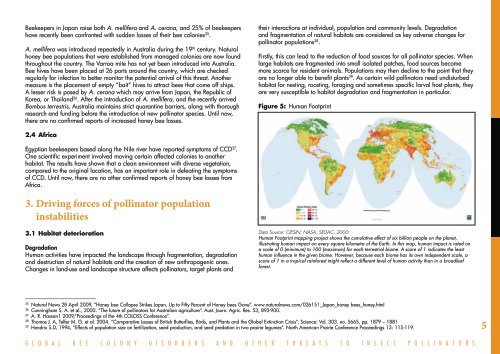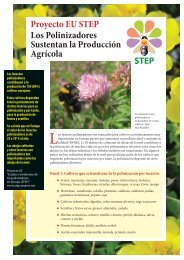Global Honey Bee Colony Disorder and Other Threats to Insect
Global Honey Bee Colony Disorder and Other Threats to Insect
Global Honey Bee Colony Disorder and Other Threats to Insect
You also want an ePaper? Increase the reach of your titles
YUMPU automatically turns print PDFs into web optimized ePapers that Google loves.
<strong>Bee</strong>keepers in Japan raise both A. mellifera <strong>and</strong> A. cerana, <strong>and</strong> 25% of beekeepershave recently been confronted with sudden losses of their bee colonies 25 .A. mellifera was introduced repeatedly in Australia during the 19 th century. Naturalhoney bee populations that were established from managed colonies are now foundthroughout the country. The Varroa mite has not yet been introduced in<strong>to</strong> Australia.<strong>Bee</strong> hives have been placed at 26 ports around the country, which are checkedregularly for infection <strong>to</strong> better moni<strong>to</strong>r the potential arrival of this threat. Anothermeasure is the placement of empty “bait” hives <strong>to</strong> attract bees that come off ships.A lesser risk is posed by A. cerana which may arrive from Japan, the Republic ofKorea, or Thail<strong>and</strong> 26 . After the introduction of A. mellifera, <strong>and</strong> the recently arrivedBombus terrestris, Australia maintains strict quarantine barriers, along with thoroughresearch <strong>and</strong> funding before the introduction of new pollina<strong>to</strong>r species. Until now,there are no confirmed reports of increased honey bee losses.their interactions at individual, population <strong>and</strong> community levels. Degradation<strong>and</strong> fragmentation of natural habitats are considered as key adverse changes forpollina<strong>to</strong>r populations 28 .Firstly, this can lead <strong>to</strong> the reduction of food sources for all pollina<strong>to</strong>r species. Whenlarge habitats are fragmented in<strong>to</strong> small isolated patches, food sources becomemore scarce for resident animals. Populations may then decline <strong>to</strong> the point that theyare no longer able <strong>to</strong> benefit plants 29 . As certain wild pollina<strong>to</strong>rs need undisturbedhabitat for nesting, roosting, foraging <strong>and</strong> sometimes specific larval host plants, theyare very susceptible <strong>to</strong> habitat degradation <strong>and</strong> fragmentation in particular.Figure 5: Human Footprint2.4 AfricaEgyptian beekeepers based along the Nile river have reported symp<strong>to</strong>ms of CCD 27 .One scientific experiment involved moving certain affected colonies <strong>to</strong> anotherhabitat. The results have shown that a clean environment with diverse vegetation,compared <strong>to</strong> the original location, has an important role in defeating the symp<strong>to</strong>msof CCD. Until now, there are no other confirmed reports of honey bee losses fromAfrica.3. Driving forces of pollina<strong>to</strong>r populationinstabilities3.1 Habitat deteriorationDegradationHuman activities have impacted the l<strong>and</strong>scape through fragmentation, degradation<strong>and</strong> destruction of natural habitats <strong>and</strong> the creation of new anthropogenic ones.Changes in l<strong>and</strong>-use <strong>and</strong> l<strong>and</strong>scape structure affects pollina<strong>to</strong>rs, target plants <strong>and</strong>Data Source: CIESIN, NASA, SEDAC, 2000:Human Footprint mapping project shows the cumulative effect of six billion people on the planet,illustrating human impact on every square kilometre of the Earth. In this map, human impact is rated ona scale of 0 (minimum) <strong>to</strong> 100 (maximum) for each terrestrial biome. A score of 1 indicates the leasthuman influence in the given biome. However, because each biome has its own independent scale, ascore of 1 in a tropical rainforest might reflect a different level of human activity than in a broadleafforest.__________________________________25Natural News 28 April 2009, “<strong>Honey</strong> bee Collapse Strikes Japan, Up <strong>to</strong> Fifty Percent of <strong>Honey</strong> bees Gone”. www.naturalnews.com/026151_Japan_honey bees_honey.html26Cunningham S. A. et al., 2000. “The future of pollina<strong>to</strong>rs for Australian agriculture”. Aust. Journ. Agric. Res. 53, 893-900.27A. R. Hassan1 2009,“Proceedings of the 4th COLOSS Conference”.28Thomas J. A, Telfer M. G. et al. 2004. “Comparative Losses of British Butterflies, Birds, <strong>and</strong> Plants <strong>and</strong> the <strong>Global</strong> Extinction Crisis”. Science: Vol. 303. no. 5665, pp. 1879 – 188129Hendrix S.D, 1994, “Effects of population size on fertilization, seed production, <strong>and</strong> seed predation in two prairie legumes”. North American Prairie Conference Proceedings 13: 115-119.5G L O B A L B E E C O L O N Y D I S O R D E R S A N D O T H E R T H R E A T S T O I N S E C T P O L L I N A T O R S




